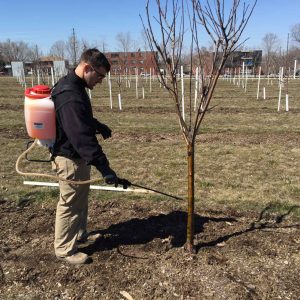When to spray apple trees?
Spraying apple trees is important for orchard management because it promotes healthy development, disease control, and maximum fruit output. Arbortrue CA recognizes the importance of good tree care, which includes effective spraying techniques tailored to the various stages of apple tree development. This tutorial will go into the best strategies and procedures for spraying apple trees, providing orchardists with the knowledge they need to maintain thriving apple trees year after year.
Importance of spraying apple trees

Keeps trees healthy and vigorous
Apple trees are prone to various pests and diseases throughout their life cycle. Strategic spraying is an early intervention that helps to prevent pests and preserve overall tree vigor. Proper spraying also guarantees that the trees can efficiently absorb nutrients and sunlight, which are required for vigorous fruit production.
Disease Prevention
One of the most common reasons for spraying apple trees is to prevent diseases like apple scab, powdery mildew, and fire blight. If not addressed, these diseases can have a severe influence on fruit quality and tree health. To reduce the danger of infection, it is vital to spray appropriate fungicides and bactericides on time during crucial growth stages.
When to spray apple trees
Sprays and their application methods
Pre-Bloom spraying
To protect against fungal infections, apply prophylactic sprays to apple trees before they bloom. At this stage, we routinely use copper-based fungicides to combat diseases like apple scab and fire blight. For efficient protection ensure complete coverage of all tree parts, including buds and branches.
Post-bloom spraying
Post-bloom sprays manage insects and prevent disease after the trees have bloomed and the fruit has begun to set. Control pests like aphids and codling moths, which can harm both leaves and fruit, with insecticidal soaps and neem oil.
Summer spraying
Apple tree health depends on managing persistent pests and diseases over the summer months. Horticultural oils, a typical summer spraying chemical, effectively manage several pests, including aphids, mites, and scale insects, without affecting beneficial insects. These oils kill pests by suffocating them and altering their life cycles.
Apply it
Mix horticultural oil according to the manufacturer’s directions, often at a 1-2% dilution. To ensure comprehensive coverage, spray the oil on all sections of the tree, including the leaf undersides. Apply it early in the morning or late in the evening to avoid leaf burns caused by high midday temperatures. Additionally, make sure the trees are well-watered before application, since stressed trees may be more sensitive to the oil. Summer spraying with horticultural oil helps apple trees stay healthy and promotes abundant fruit output.
Spray during the fall and dormant seasons.
Fall and dormant season spraying are critical for preparing apple trees for winter and keeping them healthy until spring. During this period, we widely use dormant oil sprays. These oils efficiently smother overwintering pests like scale insects and mites.

Remove any dead or diseased branches before applying dormant oil to increase ventilation and reduce potential disease sources. Mix the dormant oil according to the manufacturer’s recommendations, typically at a dilution rate of 2–3%. Spray on a quiet day with temperatures above freezing but below 60°F to ensure that the oil spreads evenly and does not freeze or evaporate too rapidly.
Ensure that you coat the entire tree, including the trunk, branches, and twigs, to cover all potential pest hiding places. This complete method eliminates insect populations before they become active in the spring, resulting in healthier apple trees and increased fruit output in the coming season.
What are the pest and disease pressures in the dormant season?
Apple trees are vulnerable to various pest and disease challenges during the dormant season, which can have an impact on their health. Scale insects and mites are common pests that spend the winter on bark and branches. These pests can harm trees by feeding on sap, resulting in stunted growth and branch dieback. Furthermore, dormant-season diseases like apple canker and powdery mildew can remain on the tree’s surface, waiting to attack new growth in the spring. Without adequate care, such as dormant oil sprays and pruning to remove affected branches, these pests and diseases can accumulate, affecting the tree’s general vitality and lowering fruit quality. Early action during the dormant season is critical for preventing these concerns from worsening and maintaining healthy apple trees come spring.
What is a fire blight?
Fire blight is a deadly bacterial disease that affects apple trees and other members of the Rosaceae family, including pears and quinces. Erwinia amylovora is the bacteria that causes it. The disease often presents as an abrupt withering and blackening of blooms, shoots, and branches, giving them a burnt or burned appearance—hence the name “fire blight.” Infected tissues frequently emit a sticky, bacterial slime. In warm, humid weather, especially after flowering, fire blight spreads quickly, and insects, rain, or pruning instruments can transmit it. Managing and reducing its influence on orchards requires the timely use of preventive treatments like copper sprays and cultural practices.
What is neem oil?
When would you spray apple trees with neem oil?
Neem oil is a natural botanical oil derived from neem tree seeds (Azadirachta indica). Organic gardening and agriculture commonly use it due to its insecticidal and fungicidal characteristics. Neem oil repels, antifeeds, and disrupts the growth of various insect pests, including aphids, scales, and mites. Additionally, it possesses antifungal characteristics that aid in the treatment of infections such as powdery mildew.
Apple trees commonly apply neem oil during the post-bloom and summer seasons to control insect pests like aphids and codling moths. When the weather is right, you can also use it as a preventive strategy against powdery mildew and other fungal diseases.
What happens if you don’t use sprays on apple trees?
Without sprays, apple trees become extremely vulnerable to pests and diseases, which can have a negative influence on their health and output. Fungal infections such as apple scab and powdery mildew are common problems that can cause defoliation and diminish fruit quality. Aphids, codling moths, and apple maggots can infest fruits and plants, causing substantial harm. Without timely spraying intervention, apple trees’ general vigor and lifespan might deteriorate, resulting in low yields and greater sensitivity to environmental challenges. Effective spraying is critical for preserving orchard health and guaranteeing excellent harvests year after year.
Related Posts:
Best practices for effective apple tree spraying
Timing and Frequency
Timing is essential when spraying apple trees. When determining the best spraying times, consider the trees’ growth degree days (GDD) and phenological stages. Regular monitoring of weather conditions and pest populations helps to adjust spray schedules for maximum effectiveness.
Equipment and Application Techniques
Investing in high-quality spraying equipment ensures even coverage while reducing spray waste. Calibrate your equipment regularly to ensure that you are spraying the correct amount per acre. To get the required effects, use the proper nozzles and pressure settings for the spray material.
Integrated pest management (IPM) approach
An integrated pest management plan, which includes cultural activities, biological controls, and monitoring tools, supplements spraying apple trees. This comprehensive method decreases dependence on chemical sprays while promoting environmentally friendly orchard management techniques.
FAQS
How often should you spray apple trees?
Spray frequency depends on weather conditions, pest pressure, and the type of spray used. During the growing season, sprays typically occur at regular intervals, often every 7–14 days during critical periods.
Is it important to swap sprays during the season?
Yes, rotating sprays with diverse modes of action keep pests from developing resistance and guarantee effective control. Incorporate integrated pest management strategies to ensure long-term orchard management success.
What should I do if it rains after I’ve sprayed the apple trees?
If rain washes away the spray soon after application, you may need to reapply according to the label directions. To maintain efficacy, monitor weather forecasts and alter spray schedules.
How can I safely and effectively spray my apple trees?
Follow all label directions for mixing, application rates, and safety measures. To ensure safety and environmental responsibility, use calibrated equipment, wear suitable protective gear, and appropriately store and dispose of chemicals.
Conclusion
When to spray apple trees and to master the art of spraying apple trees, you must be diligent, understand tree biology, and be aware of pest dynamics. ArbortrueCA promotes proactive tree care through spraying procedures tailored to the unique needs of apple orchards. Orchardists can obtain healthier trees and more abundant harvests by following these rules and remaining up-to-date on the newest advances in orchard management.




